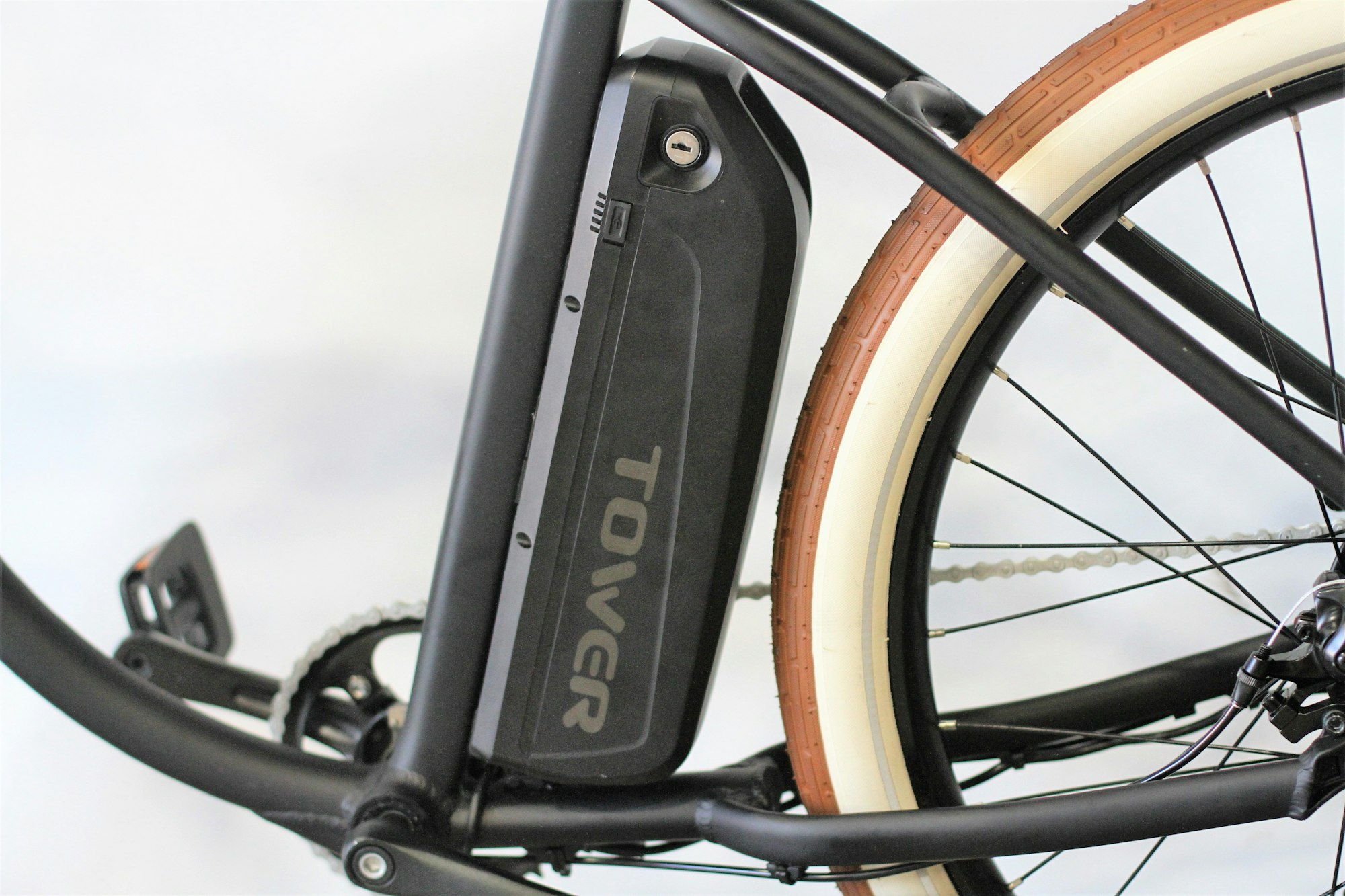This post will review all the elements that add to an e-bike's hefty weight and why it can benefit you.
Thanks to our electric bike insurance, we’ll also give you plenty of reasons to take the unnecessary weight of worry off your shoulders. Let’s get started!
E-Bike Motors and Batteries: Weighing the Options
An electric motor usually adds an extra 8kg to a bike. E-bike motors generally weigh between 3 and 4 kg, with variations based on their design and power output. You'll encounter two main types - hub-mounted and mid-mounted motors, each contributing differently to the bike's weight.
Hub-Mounted Motor
This type is located in the centre of the rear wheel, directly turning it. These motors, typically lighter, are ideal for less technical terrains and beginner riders. They're user-friendly but can add weight to the rear, affecting the bike's balance.
Mid-Mounted Motor
Positioned low in the frame, between the cranks, these motors link to the rear wheel via the front chainring. They offer greater efficiency, allowing for longer rides before recharging.
Mid-mounted motors might be slightly heavier, but their strategic placement ensures optimal balance, which is crucial for electric mountain bikes tackling challenging trails.
Advancements in Motor Technology
E-bike motors are evolving rapidly, with advancements focusing on reducing weight and enhancing power. We're seeing the emergence of more compact, lighter motors without compromising motor power.
This innovation hints at a future where electric bikes can match the lightness of a conventional bike, making them more versatile and easier to handle.
The Role of Battery Capacity in E-Bike Weight
Most modern electric bikes now use lithium-ion batteries. These are much lighter, smaller, and more charged than the old lead-acid versions. Lithium-ion batteries weigh between 2 and 3.5kg. Still, their weight is determined by their capacity and how the manufacturer has built it.
A battery with a high capacity will weigh much more than one with less power. This is worth remembering, as you may want to carry an extra battery as a range extender in your backpack. A heavy battery on your back will raise your centre of gravity, affecting your ride.
Without a good battery, e-bikes wouldn’t be possible, so consider learning how to keep your e-bike battery safe for added peace of mind.
The Electrical Anatomy of E-Bikes
Electric bikes incorporate various electrical components, each contributing to the overall weight while enhancing the bike's functionality and user experience.
Interactive Display Unit
Mounted on the handlebars, the display unit acts as a computer, allowing riders to select assistance levels and monitor battery status. Its integration adds weight to the front of the bike.
The Controller System
Using a cadence sensor for hub-mounted motors or a torque sensor for mid-drive engines, this system adjusts the motor's power output based on real-time data. It's essential for responsive and smooth riding.
Wiring Circuits
A network of wiring circuits connects all electrical components, running through the bike's frame. Although each element is light, collectively, they add a noticeable heft. This network ensures that all electrical components communicate efficiently, enhancing the bike's performance and safety.
The Significance of Heavy-Duty Tyres in Electric Bikes
An electric bike's motor's power and torque are substantially higher than a standard bike's, necessitating heavy-duty tyres.
These tyres are not just an afterthought but a critical component for safety and performance, especially for electric mountain bikes where the demands on tyres are significantly increased.
If you want to learn everything there is to know about bicycle tyres, check out our complete guide to e-bike tyre sizes.
Enhanced Safety and Performance with Heavy-Duty Tyres
The motor's additional demand on tyre tread can be immense for electric mountain bikes. To address this, manufacturers craft tyres that are more resistant to wear and tear. This durability is essential not just for longevity but also for rider safety.
These tyres improve performance on various terrains, are puncture-resistant, and provide greater stopping power during braking. This enhanced functionality is crucial when navigating challenging off-road paths or steep descents, where control and stability are paramount.
Weight vs Durability
In tyre design, there's a delicate balance between weight and durability. Electric bike tyres typically have a more complex compound to reduce rolling resistance and boost efficiency. While this makes them slightly heavier than regular bike tyres, the added weight is a trade-off for increased durability and better performance.
The sturdier build of these tyres ensures they can withstand the heavier loads and higher speeds of electric bikes, ultimately contributing to a safer, more reliable ride.
Beefed-Up Frame And Components in E-Bikes
Another way electric bike manufacturers design their bikes to cope with the power is to beef everything up. The frame designers need to place the battery and related components safely. But the frame also needs to cope with the weight of the motor and battery system.
Robust Frames for Battery and Motor
Frames are designed to house the battery and related components securely while being strong enough to support the motor and battery system's weight.
Advanced Frame Materials
Materials like aluminium and carbon fibre are used for their strength and lightness, with carbon frames being trendy for their excellent strength-to-weight ratio. Remember to protect your structure with e-bike carbon fibre protection.
Reinforced Suspension Systems
Especially in electric mountain bikes, suspensions are beefed up to handle the additional weight and stress from the motor system.
Upgraded Brakes and Wheels
Brakes are enhanced to cope with higher speeds and increased weight, and wheels are fortified to support the additional load.
Balancing Weight and Durability
Manufacturers meticulously select components that balance durability and weight efficiency, ensuring safety and practicality.
How Extra Weight Affects Your E-Bike Rides
The main attraction of electric bike ownership is its ease of manoeuvrability and its effortless experience. The impact of the extra weight of an electric bike, however, varies depending on the type of riding - be it urban commuting or mountain biking.
Urban Commuting
An electric bike's extra weight can be beneficial in an urban setting. It provides a stable and smooth ride, which is particularly noticeable in stop-and-go traffic.
The weight aids in maintaining momentum, making it easier to navigate through city streets.
However, urban riders who often commute by bike may need to carry their e-bike upstairs or onto public transport - the added weight can be a challenge.
Mountain Biking
The additional weight plays a crucial role in the performance of electric mountain bikes. The extra weight adds stability on downhill trails, allowing for more confident and faster descents. The low centre of gravity, especially with mid-mounted motors, improves cornering and overall control on uneven terrain.
Extra Weight and Hill Climbing
Electric bikes truly excel when climbing steep hills. The additional power from the motor effectively counterbalances the bike's extra weight, providing a significant boost that makes uphill rides quicker and less strenuous than regular bikes.
Impact on Battery Efficiency and Range
The weight of an electric bike also has implications for battery efficiency and range. Heavier bikes require more energy to move, which can lead to quicker battery drainage, especially in scenarios involving frequent stops, starts, and climbs.
The battery might deplete faster for longer rides or more demanding routes than on a lighter bike. Riders should consider this when planning longer trips, carrying a spare battery for extended range.
Handling a Flat Battery
If you find yourself with a depleted battery, particularly on an uphill ride, the weight of the electric bike can become more noticeable.
A heavy electric bike without motor assistance demands more physical effort, especially on inclines. This aspect is essential for riders who venture far from charging points or prefer longer excursions.
A Lighter, Stronger, and More Versatile Future Awaits
With all the extra components an electric bike has, it is no wonder why they are much heavier than regular bikes. These more robust components weigh little individually, but their accumulative weight adds up.
Most of the time, you won't notice the extra weight. Electric bike manufacturers do their best to make their bikes feel as natural as possible. However, depending on your situation, the weight of picking the bike up may make it less practical for you.
The electric bike industry is rapidly evolving, with new types of e-bikes emerging to cater to a wide range of users. From urban commuters who value convenience and ease of use to adventure seekers looking for rugged and powerful machines for off-road exploration, the diversity in electric bike designs is expanding.
The Future of E-Bikes
As the technology and manufacturing processes improve, there is no doubt that electric bikes will become lighter. This will make the practical issues more manageable while increasing how far you can ride between charges.
Insurance for Electric Bikes
Get covered for theft, accidental damage, full battery cover, loss and more. Try our 5-star reviewed e-bike insurance. With no excess & travel cover included, it's e-bike insurance, and then some.






